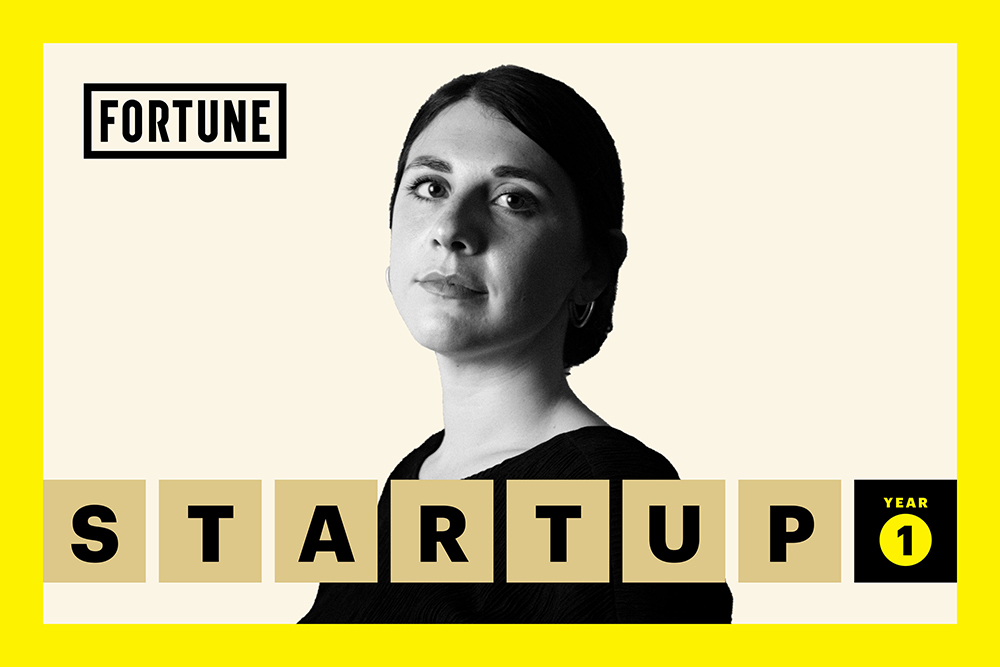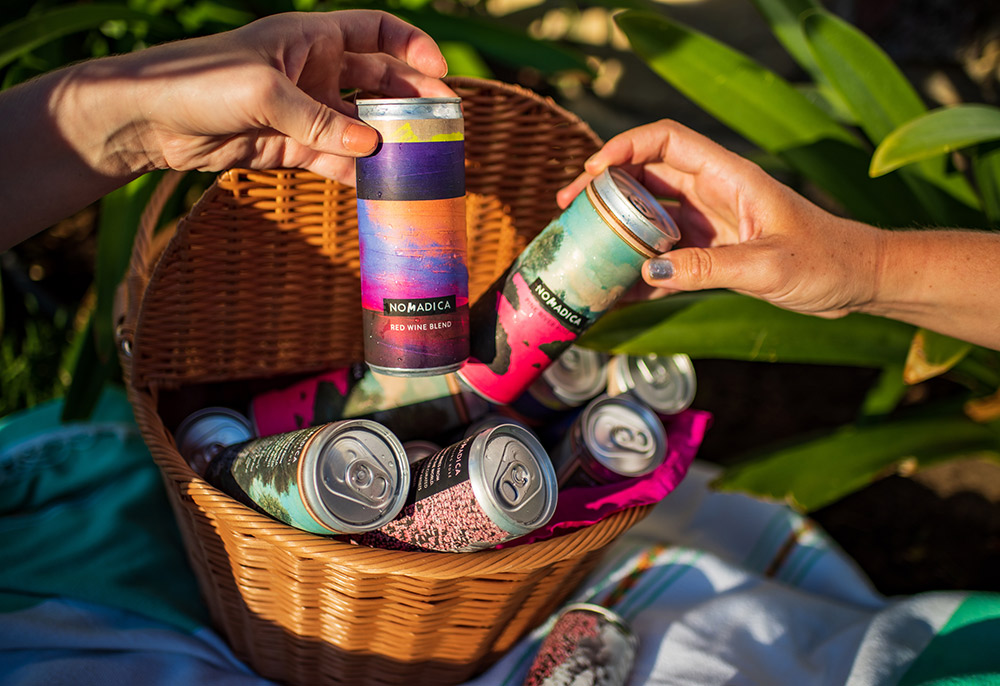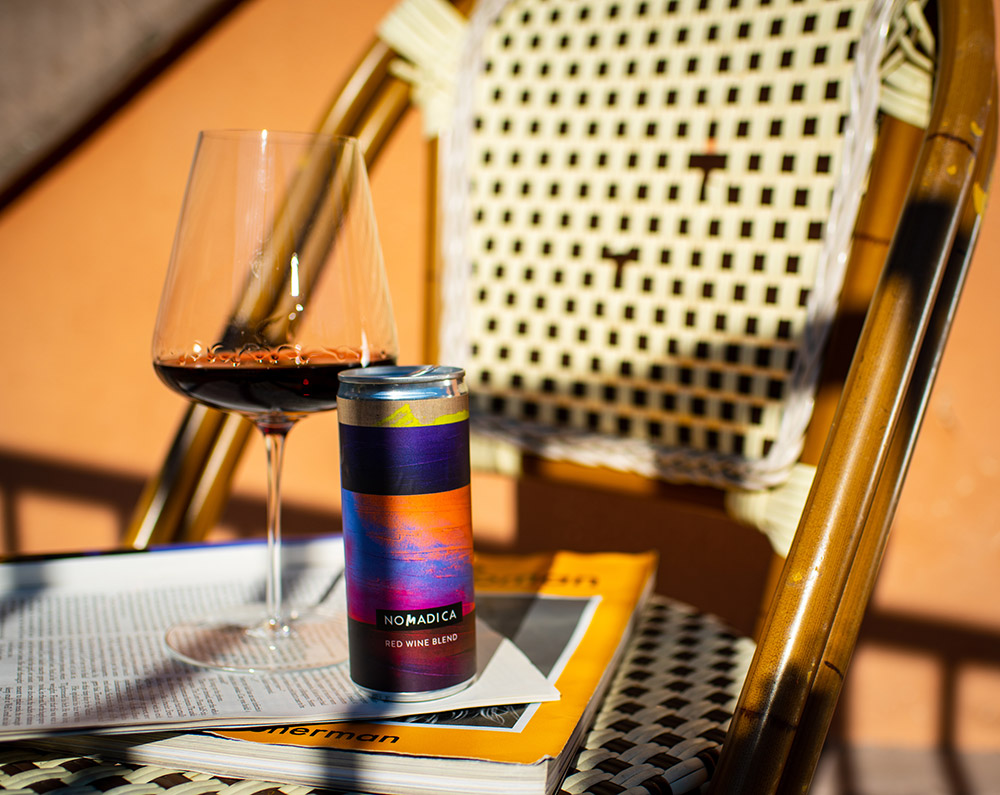葡萄酒业的艰难时刻,我怎样卖酒
克莉丝汀·奥尔谢夫斯基的职业生涯始于餐饮业,她在美国旧金山湾区的几家餐厅工作过。在米其林星级餐厅Saison任职期间,她对葡萄酒产生了极大的兴趣。在美国哈佛大学取得医学学士后学位后,奥尔谢夫斯基意识到自己真正热爱的是葡萄酒和餐饮业,因此没有从医,转而继续获得品酒师认证。在此基础上,她在美国楠塔基特岛Straight Wharf Restaurant餐厅和美国那什维尔获奖餐厅Husk担任品酒师,继续深化这方面的知识。随后搬回美国西部,成为了美国棕榈泉F10 Creative公司的葡萄酒项目负责人。
2017年,奥尔谢夫斯基加入Osteria Mozza餐厅,任品酒师。该餐厅位于美国洛杉矶,老板是南茜·席维顿(美国著名大厨——译注)。在此期间,奥尔谢夫斯基与艾玛·托沙克联合创立了罐装葡萄酒品牌Nomadica,旨在改变大家饮用和看待葡萄酒的方式。Nomadica从精品葡萄酒酒庄采购葡萄酒,把酒装在雅致的易拉罐中,易拉罐上绘制的限量版艺术作品,出自独立插画师、画家、雕塑家、摄影师和街头艺术家之手。另外,这两名联合创始人称,Nomadica采用的易拉罐重量仅为玻璃瓶的1/400,因此与玻璃瓶相比,运输过程中碳排放减少了80%,使该品牌成为了更加可持续的葡萄酒饮用选择。奥尔谢夫斯基还兼任Gigi’s的葡萄酒总监,这是今年秋季新开的法国小酒馆,位于好莱坞。
最近,《财富》杂志采访了奥尔谢夫斯基和Nomadica的新任首席运营官塔拉·汉纳福德,了解到公司创业第一年的情况以及下一步规划。
为清晰起见,以下采访内容有所精简和编辑。

《财富》:能分享一下你们的教育背景吗?在推出Nomadica之前,你们的职业是什么?
克莉丝汀·奥尔谢夫斯基:我本科就读于美国马萨诸塞大学安姆斯特分校,专业是可持续农业和性别研究。毕业后搬到了旧金山,在几家米其林星级餐厅频繁跳槽。在Sons & Daughters Group工作期间,[品酒师和葡萄酒总监]卡琳·卡尔带我入了葡萄酒的门,从这以后就容易了。我记得当时感到惊叹不已,因为平价就可以买到相当不错的葡萄酒;跟随卡琳品酒之前,我一直感到葡萄酒对普通人来说是遥不可及的。
之后,我又短暂回到了东海岸,前往哈佛大学医学院学习了一个项目,最后在波士顿一家很棒的葡萄酒酒吧Spoke Wine Bar找到了工作。酒吧主人Flea Foster带我品酒,让我对这方面的能力建立了信心。于是我鼓起勇气离开学校,追寻葡萄酒事业。从那时起,我就便成为了Straight Wharf Restaurant餐厅、F10 Group、Husk餐厅、Osteria Mozza餐厅和Gigi’s小酒馆的品酒师和葡萄酒总监。我全身心沉浸在葡萄酒的世界里,对“新”加州、法国和意大利葡萄酒情有独钟。让我感到欣喜的是,葡萄酒给予了支持农民的机会,他们才是这片土地上真正的管家。
塔拉·汉纳福德:我在葡萄酒和烈酒品牌建设领域工作了12年。我从小在餐饮业长大,谋得这个行业的专业职位也不足为奇;这种生意有很强的家族特色,精于此道是与生俱来的。在我的职业生涯中,一直与初创公司打交道,从开始阶段到收购,经验丰富。我负责过三家龙舌兰公司的出售;Peligroso、DeLeón和Casamigos。这些公司的收购方都是帝亚吉欧(Diageo)。打造产品、建设团队和制定全美战略,都是我热爱的品牌建设业务的方方面面。这项事业有极大的挑战性,要求每天都充满紧迫感,但回报也相当令人满意。
为了回答问题,再讲点不那么有趣的经历:我的教育背景是表演艺术,做了多年的专业舞者。后来我重返校园,就读于美国洛约拉玛丽蒙特大学,学习政治学专业,正准备去华盛顿哥伦比亚特区的法学院继续深造。但那时我延期入学,于2008年进入饮料行业。

推出Nomadica的灵感源自哪里?你们的目标客户有哪些?
奥尔谢夫斯基:我们之所以推出Nomadica,是因为觉得易拉罐在很多方面都非常合理:易拉罐比玻璃瓶更具可持续性,是保持葡萄酒新鲜度的绝佳方式。一人饮用刚好,无需开整瓶。
我们的目标客户是任何喜爱葡萄酒的人。我知道,如果在我家,开了一瓶葡萄酒之后,就不可能再放回冰箱了;Nomadica让饮用葡萄酒更方便:大家可以享用一人份,或者在不用开很多瓶的情况下,喝到不同的酒款。这也类似于我十多年在餐厅里做的工作:从寻找广受欢迎的、适合所有场合的高品质风味酒款货源中获得了无限乐趣。
创业第一年,你们遇到的最大困难是什么?让你们感到最惊喜的是什么?
奥尔谢夫斯基:我们遇到的最大困难当然源自我们在罐装葡萄酒领域独树一帜的事实。幸好,近年来一直都有出色的制造商把很棒的果汁装在易拉罐中。但赢得买家还是一项艰巨的任务。在这个世界上,我最喜欢的事情就是坐下来,跟葡萄酒专业人士一道品尝我们的葡萄酒,同时看到他们脸上震惊的表情。在优质罐装葡萄酒变得更加普及、得到更多理解的同时,我们的业务也随之增长。
让我们感到最惊喜的一件事情,是有大量的女性企业家竭尽全力支持我们。无论是顾问、合作还是人脉,真的是有数量惊人的女性在支持我们。

这一年对葡萄酒行业来说是艰难的一年,从过去几年参差不齐的全美销售额到美国西海岸山火肆虐,都可以印证这一点。尽管如此,葡萄酒交货和直接面向消费者的销售额在疫情期间仍然保持快速增长。推测起来,罐装葡萄酒似乎是消费者户外社交的理想选择。过去几个月,公司的状况如何?跟供应链合作伙伴和运输服务公司协作的感觉如何?
汉纳福德:我们制定过在2020年推出电子商务模式的计划,但不是以新冠疫情推着我们走的速度。凭借长期的行业关系,我们通过批发渠道战略性地开发业务,在很大程度上依赖于本地部署。作为思路敏捷的小团队,我们能够快速转型,但要做到与品牌相符并保持在较高水平上,需要齐心协力,还需要招到了不起的创意总监把我们的愿景落到实处。
好的方面是,可以更快转型到我们的新形式:易拉罐。我们采用了这种新形式,产品自然而然地就是未被污染的一人份,这是大家喜欢的特质。我们喝得越多,就越有助于产品提供负责任的消费控制。我们发现,无论是打包带走的客户,还是希望在保持社交距离聚会期间在家分享的消费者,都对饮用我们的产品有极大的兴趣。
即便如此,Nomadica如何实现筹资?主要是自筹资金、风投支持,还是两者皆有?
汉纳福德:我们通过风险投资和热爱葡萄酒的天使投资人这两种方式来筹资。我们一直深思熟虑,也有战略性眼光,因为我们想要的,不止是获得筹资合作伙伴的资本注入;他们也在某种程度上塑造了我们的企业文化,与对我们全职团队的影响程度不相上下。

如果对后疫情时代作五年展望,你认为Nomadica会在市场上处于什么位置?
汉纳福德:罐装葡萄酒并不是一时的风尚;过去三年,这个品类呈现两位数的持续高速增长,也没有放缓的迹象。这一领域的早期进入者是大家熟悉的、售卖750毫升葡萄酒的公司,这些企业当时只是为不怎么重视葡萄酒、注重市场营销活动的公司推出罐装酒这种产品选择。
Nomadica看到了这个领域的机会,因为可持续性是道德方面的当务之急。公司与备受尊敬的酒庄合作,打造能够与现有葡萄酒饮用者和任何味觉灵敏和挑剔的人交流的罐装葡萄酒。我们正在这块高端的细分市场上冲锋陷阵,会看到更多的人每天在这个领域寻找高质量的产品。(财富中文网)
译者:夏晴
克莉丝汀·奥尔谢夫斯基的职业生涯始于餐饮业,她在美国旧金山湾区的几家餐厅工作过。在米其林星级餐厅Saison任职期间,她对葡萄酒产生了极大的兴趣。在美国哈佛大学取得医学学士后学位后,奥尔谢夫斯基意识到自己真正热爱的是葡萄酒和餐饮业,因此没有从医,转而继续获得品酒师认证。在此基础上,她在美国楠塔基特岛Straight Wharf Restaurant餐厅和美国那什维尔获奖餐厅Husk担任品酒师,继续深化这方面的知识。随后搬回美国西部,成为了美国棕榈泉F10 Creative公司的葡萄酒项目负责人。
2017年,奥尔谢夫斯基加入Osteria Mozza餐厅,任品酒师。该餐厅位于美国洛杉矶,老板是南茜·席维顿(美国著名大厨——译注)。在此期间,奥尔谢夫斯基与艾玛·托沙克联合创立了罐装葡萄酒品牌Nomadica,旨在改变大家饮用和看待葡萄酒的方式。Nomadica从精品葡萄酒酒庄采购葡萄酒,把酒装在雅致的易拉罐中,易拉罐上绘制的限量版艺术作品,出自独立插画师、画家、雕塑家、摄影师和街头艺术家之手。另外,这两名联合创始人称,Nomadica采用的易拉罐重量仅为玻璃瓶的1/400,因此与玻璃瓶相比,运输过程中碳排放减少了80%,使该品牌成为了更加可持续的葡萄酒饮用选择。奥尔谢夫斯基还兼任Gigi’s的葡萄酒总监,这是今年秋季新开的法国小酒馆,位于好莱坞。
最近,《财富》杂志采访了奥尔谢夫斯基和Nomadica的新任首席运营官塔拉·汉纳福德,了解到公司创业第一年的情况以及下一步规划。
为清晰起见,以下采访内容有所精简和编辑。
《财富》:能分享一下你们的教育背景吗?在推出Nomadica之前,你们的职业是什么?
克莉丝汀·奥尔谢夫斯基:我本科就读于美国马萨诸塞大学安姆斯特分校,专业是可持续农业和性别研究。毕业后搬到了旧金山,在几家米其林星级餐厅频繁跳槽。在Sons & Daughters Group工作期间,[品酒师和葡萄酒总监]卡琳·卡尔带我入了葡萄酒的门,从这以后就容易了。我记得当时感到惊叹不已,因为平价就可以买到相当不错的葡萄酒;跟随卡琳品酒之前,我一直感到葡萄酒对普通人来说是遥不可及的。
之后,我又短暂回到了东海岸,前往哈佛大学医学院学习了一个项目,最后在波士顿一家很棒的葡萄酒酒吧Spoke Wine Bar找到了工作。酒吧主人Flea Foster带我品酒,让我对这方面的能力建立了信心。于是我鼓起勇气离开学校,追寻葡萄酒事业。从那时起,我就便成为了Straight Wharf Restaurant餐厅、F10 Group、Husk餐厅、Osteria Mozza餐厅和Gigi’s小酒馆的品酒师和葡萄酒总监。我全身心沉浸在葡萄酒的世界里,对“新”加州、法国和意大利葡萄酒情有独钟。让我感到欣喜的是,葡萄酒给予了支持农民的机会,他们才是这片土地上真正的管家。
塔拉·汉纳福德:我在葡萄酒和烈酒品牌建设领域工作了12年。我从小在餐饮业长大,谋得这个行业的专业职位也不足为奇;这种生意有很强的家族特色,精于此道是与生俱来的。在我的职业生涯中,一直与初创公司打交道,从开始阶段到收购,经验丰富。我负责过三家龙舌兰公司的出售;Peligroso、DeLeón和Casamigos。这些公司的收购方都是帝亚吉欧(Diageo)。打造产品、建设团队和制定全美战略,都是我热爱的品牌建设业务的方方面面。这项事业有极大的挑战性,要求每天都充满紧迫感,但回报也相当令人满意。
为了回答问题,再讲点不那么有趣的经历:我的教育背景是表演艺术,做了多年的专业舞者。后来我重返校园,就读于美国洛约拉玛丽蒙特大学,学习政治学专业,正准备去华盛顿哥伦比亚特区的法学院继续深造。但那时我延期入学,于2008年进入饮料行业。
推出Nomadica的灵感源自哪里?你们的目标客户有哪些?
奥尔谢夫斯基:我们之所以推出Nomadica,是因为觉得易拉罐在很多方面都非常合理:易拉罐比玻璃瓶更具可持续性,是保持葡萄酒新鲜度的绝佳方式。一人饮用刚好,无需开整瓶。
我们的目标客户是任何喜爱葡萄酒的人。我知道,如果在我家,开了一瓶葡萄酒之后,就不可能再放回冰箱了;Nomadica让饮用葡萄酒更方便:大家可以享用一人份,或者在不用开很多瓶的情况下,喝到不同的酒款。这也类似于我十多年在餐厅里做的工作:从寻找广受欢迎的、适合所有场合的高品质风味酒款货源中获得了无限乐趣。
创业第一年,你们遇到的最大困难是什么?让你们感到最惊喜的是什么?
奥尔谢夫斯基:我们遇到的最大困难当然源自我们在罐装葡萄酒领域独树一帜的事实。幸好,近年来一直都有出色的制造商把很棒的果汁装在易拉罐中。但赢得买家还是一项艰巨的任务。在这个世界上,我最喜欢的事情就是坐下来,跟葡萄酒专业人士一道品尝我们的葡萄酒,同时看到他们脸上震惊的表情。在优质罐装葡萄酒变得更加普及、得到更多理解的同时,我们的业务也随之增长。
让我们感到最惊喜的一件事情,是有大量的女性企业家竭尽全力支持我们。无论是顾问、合作还是人脉,真的是有数量惊人的女性在支持我们。
这一年对葡萄酒行业来说是艰难的一年,从过去几年参差不齐的全美销售额到美国西海岸山火肆虐,都可以印证这一点。尽管如此,葡萄酒交货和直接面向消费者的销售额在疫情期间仍然保持快速增长。推测起来,罐装葡萄酒似乎是消费者户外社交的理想选择。过去几个月,公司的状况如何?跟供应链合作伙伴和运输服务公司协作的感觉如何?
汉纳福德:我们制定过在2020年推出电子商务模式的计划,但不是以新冠疫情推着我们走的速度。凭借长期的行业关系,我们通过批发渠道战略性地开发业务,在很大程度上依赖于本地部署。作为思路敏捷的小团队,我们能够快速转型,但要做到与品牌相符并保持在较高水平上,需要齐心协力,还需要招到了不起的创意总监把我们的愿景落到实处。
好的方面是,可以更快转型到我们的新形式:易拉罐。我们采用了这种新形式,产品自然而然地就是未被污染的一人份,这是大家喜欢的特质。我们喝得越多,就越有助于产品提供负责任的消费控制。我们发现,无论是打包带走的客户,还是希望在保持社交距离聚会期间在家分享的消费者,都对饮用我们的产品有极大的兴趣。
即便如此,Nomadica如何实现筹资?主要是自筹资金、风投支持,还是两者皆有?
汉纳福德:我们通过风险投资和热爱葡萄酒的天使投资人这两种方式来筹资。我们一直深思熟虑,也有战略性眼光,因为我们想要的,不止是获得筹资合作伙伴的资本注入;他们也在某种程度上塑造了我们的企业文化,与对我们全职团队的影响程度不相上下。
如果对后疫情时代作五年展望,你认为Nomadica会在市场上处于什么位置?
汉纳福德:罐装葡萄酒并不是一时的风尚;过去三年,这个品类呈现两位数的持续高速增长,也没有放缓的迹象。这一领域的早期进入者是大家熟悉的、售卖750毫升葡萄酒的公司,这些企业当时只是为不怎么重视葡萄酒、注重市场营销活动的公司推出罐装酒这种产品选择。
Nomadica看到了这个领域的机会,因为可持续性是道德方面的当务之急。公司与备受尊敬的酒庄合作,打造能够与现有葡萄酒饮用者和任何味觉灵敏和挑剔的人交流的罐装葡萄酒。我们正在这块高端的细分市场上冲锋陷阵,会看到更多的人每天在这个领域寻找高质量的产品。(财富中文网)
译者:夏晴
Kristin Olszewski got her start in the hospitality industry while working in restaurants in the Bay Area and became enamored with wine while working at Michelin-starred Saison. After pursuing a postbaccalaureate in medicine at Harvard, she realized she’d fallen in love with the wine and restaurant industries and instead went on to get her sommelier certification. From there, she furthered her depth of knowledge as a sommelier at Straight Wharf Restaurant in Nantucket and the award-winning Husk Nashville before moving back out West to head the wine program for F10 Creative in Palm Springs.
In 2017, while on the sommelier team at Nancy Silverton’s Osteria Mozza in Los Angeles, Olszewski founded canned wine brand Nomadica with Emma Toshack to change the way that people consume and think about wine. Nomadica sources its wines from boutique winemakers, packaging them in chic cans with limited-edition art from independent illustrators, painters, sculptors, photographers, and street artists. Additionally, because glass bottles are 400 times as heavy as cans, the Nomadica brand reduces emissions from shipping by up to 80%, making it a more sustainable wine-drinking choice, according to the cofounders. Olszewski is also the wine director of Gigi’s, a new French bistro opening in Hollywood this fall.
Fortune recently spoke with Olszewski, as well as Tara Hannaford, Nomadica’s new chief operating officer, about how the first year has been and what the company plans to do next.
The following interview has been condensed and lightly edited for clarity.
Fortune: Could you tell me a bit about your backgrounds? What were you doing professionally prior to launching Nomadica?
Kristin Olszewski: I majored in sustainable farming and gender studies at the University of Massachusetts at Amherst, and ended up moving to San Francisco after graduating to work in a revolving door of Michelin-starred restaurants. While working for the Sons & Daughters Group, [sommelier and wine director] Carlin Karr really introduced me to the world of wine, and it was all downhill from there. I remember being amazed that you could find incredible wine at affordable prices; before tasting with Carlin, I always felt like wine was so inaccessible.
I did a brief detour back to the East Coast on the med school track at Harvard and ended up working at this incredible wine bar, Spoke Wine Bar, in Boston. Flea Foster, the owner, took time to taste with me, develop my confidence in my own ability, and gave me the courage I needed to leave school and pursue wine. Since then, I’ve been a sommelier and wine director at Straight Wharf Restaurant, F10 Group, Husk, Osteria Mozza, and Gigi’s. I’m completely obsessed with wine; passionate about the “new” California, France, and Italy. I love that wine gives an opportunity to support farmers who are truly stewards of the land.
Tara Hannaford: I’ve been working in wine and spirits on the brand side for 12 years. I grew up in the hospitality business so landing in the space professionally isn’t a surprise; this business is very familial and tends to be in your blood. My career has been spent working with startups, from the ground floor up to acquisition. I’ve led sales at three tequila companies: Peligroso, DeLeón, Casamigos—all acquired by Diageo. Creating products, building teams, and national strategy are all aspects of the brand-building business that I love. It’s wildly challenging, requires a daily sense of urgency, but the reward is incredibly fulfilling.
Less interesting, but to answer the question: I have a background in performance art and worked as a professional dancer for many years. When I went back to college at Loyola Marymount, I studied political science and was on my way to law school in D.C. when I deferred and jumped into the beverage industry in 2008.
What inspired the launch of Nomadica? Who is your target audience?
Olszewski: We were inspired to launch Nomadica because cans make sense in so many ways; they’re much more sustainable than glass, a great way to preserve freshness in a wine, and an amazing way to just have a single serving without having to open an entire bottle.
Our target audience is anyone who loves wine. I know that in my house, if I open up a bottle it’s not going back in the fridge; Nomadica makes it easy for wine drinkers to consume a single serving of wine or consume multiple styles of wine without having to open up multiple bottles. Just as I’ve done for over a decade on the floor of restaurants, I take so much joy in sourcing universally loved, high-quality flavor profiles that suit all occasions.
What were some of the biggest hurdles of your first year in business? What surprised you the most?
Olszewski: Our biggest hurdle was certainly the fact that we are really doing something unique in the canned wine space. Thankfully, in recent years, there have been several amazing producers also putting great juice into cans. But it can still be an uphill battle with buyers. My favorite thing in the world is to sit down and taste our wines with wine professionals and see the look of shock and surprise on their faces. As quality canned wine becomes more popular and understood, we’ve seen our business grow with it.
One of the most pleasant surprises was how many female entrepreneurs went out of their way to support us. Whether it was mentorship, collaborations, or connections, there was truly an overabundance of women supporting us.
While it has been a rough year for the wine industry, from uneven domestic sales over the past few years to wildfires raging up and down the West Coast, delivery and direct-to-consumer sales for wine have shot upward during the pandemic. Presumably, it would seem canned wine would also be an ideal choice for customers looking to socialize outdoors. How have the past several months gone for your company? What has it been like to work with supply chain partners and shipping services?
Hannaford: We had planned to launch our e-commerce model in 2020 but not at the speed COVID-19 threw us into. Because of our long-standing industry relationships, we built the business strategically through our wholesale channels and heavily on-premise. As a small and nimble team, we were able to pivot quickly, but to do it on-brand and at an elevated level required all hands on deck—and hiring a badass creative director to bring our vision to life.
The upside has been a much quicker conversion to our new format: cans. People love the uncontaminated, single-serving feature naturally provided in our form factor, and with many of us drinking more, the responsible consumption control it helps provide. We’ve seen a huge interest uptake in our product from both accounts offering to-go and customers wanting to share it at home during their socially distanced hangouts.
That said, what has it been like to secure funding for Nomadica? Is it primarily self-funded, VC-backed, or some mixture of both?
Hannaford: We’re funded by a mix of venture capital and wine-loving angel investors. We have been thoughtful and strategic because we want more than just a capital injection from our funding partners; they shape our culture just as much as our full-time team.
Post-pandemic and five years down the road, where do you see Nomadica in the market?
Hannaford: Canned wine is not a fad; the category has seen high double-digit sustained growth over the past three years with no signs of slowing down. Early entrants were familiar 750-milliliter companies simply launching a can option to less–wine focused, heavy marketing campaigned companies.
Nomadica saw an opportunity in the space for sustainability as a moral imperative, while working with respected winemakers to can product that speaks to existing wine drinkers and anyone with a refined and curious palate. We’re leading the charge in the premium segment and see more people looking for high-quality offerings in the space everyday.













